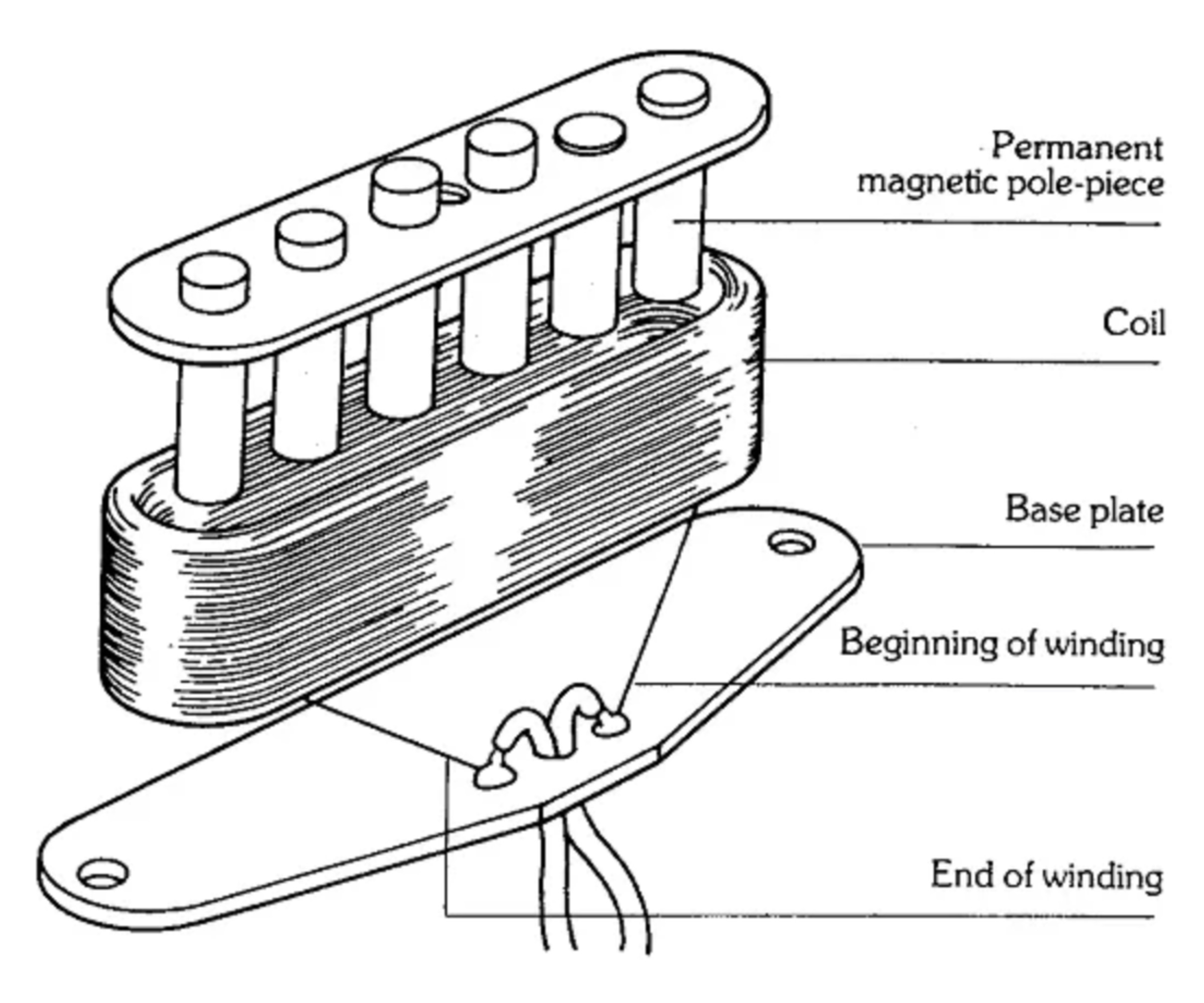The Science of the Electric Guitar
September 1, 2024 / Sound

The unique sound of the electric guitar owes much of its magic to a simple and overlooked, yet crucial component: the pickup. Functioning at the ears of the instrument, pickups are small devices that convert the vibrations of metal strings into electrical signals that are amplified and transformed into music.
Acting as transducers, pickups use principles of electromagnetism to capture subtle nuances in string vibrations, a process involving the inducing electrical currents in coils of wire, generating a signal that faithfully represents the sound of the vibrating strings.
To further understand how a pickup works, we must first understand the anatomy of the devices.
A typical pickup consists of six cylindrical polar magnets with the south pole facing the guitar strings, a coil of copper wire wrapped around the magnets, and a base plate. When the metal strings of the guitar vibrate, it disturbs the magnetic field of the cylindrical; magnets inducing a small electrical current in the copper wire.
There are two basic types of pickups with a similar anatomy used in the common electric guitar, single coil and humbucker pickups. Both types fulfill the same purpose, but are constructed slightly differently.
A single coil pickup consists of a single coil of copper wire wrapped around the magnets, whereas the humbucker consists of two coils wired in a series, with the second coil’s magnets, or pole pieces inverted. We’ll get into the differences of functionality and tonal quality later.
So now that we know the structure of pickups, how do they transfer the vibrations of guitar strings into those electrical signals that are read by the amplifier?
Firstly, let’s look at the role of the pole pieces. Like all magnets, the pole pieces are composed of molecules that are arranged so that the electrons spin in the same direction. This movement creates a magnetic force that flows from the north seeking pole to a south seeking pole, creating the magnetic field around the pole pieces. Because of the magnetism of the pickup, the strings of the guitar also become magnetized. When these strings vibrate, they cause a disturbance in the field of the pole pieces.
Acting as transducers, pickups use principles of electromagnetism to capture subtle nuances in string vibrations, a process involving the inducing electrical currents in coils of wire, generating a signal that faithfully represents the sound of the vibrating strings.
To further understand how a pickup works, we must first understand the anatomy of the devices.
A typical pickup consists of six cylindrical polar magnets with the south pole facing the guitar strings, a coil of copper wire wrapped around the magnets, and a base plate. When the metal strings of the guitar vibrate, it disturbs the magnetic field of the cylindrical; magnets inducing a small electrical current in the copper wire.
There are two basic types of pickups with a similar anatomy used in the common electric guitar, single coil and humbucker pickups. Both types fulfill the same purpose, but are constructed slightly differently.
A single coil pickup consists of a single coil of copper wire wrapped around the magnets, whereas the humbucker consists of two coils wired in a series, with the second coil’s magnets, or pole pieces inverted. We’ll get into the differences of functionality and tonal quality later.
So now that we know the structure of pickups, how do they transfer the vibrations of guitar strings into those electrical signals that are read by the amplifier?
Firstly, let’s look at the role of the pole pieces. Like all magnets, the pole pieces are composed of molecules that are arranged so that the electrons spin in the same direction. This movement creates a magnetic force that flows from the north seeking pole to a south seeking pole, creating the magnetic field around the pole pieces. Because of the magnetism of the pickup, the strings of the guitar also become magnetized. When these strings vibrate, they cause a disturbance in the field of the pole pieces.

